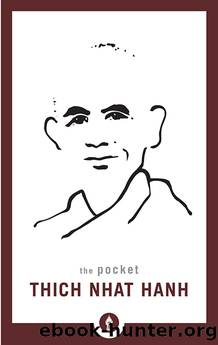The Pocket Thich Nhat Hanh by Thich Nhat Hanh

Author:Thich Nhat Hanh
Language: eng
Format: epub
Publisher: Shambhala
3
EMOTIONS AND RELATIONSHIPS
THE WOUNDED CHILD INSIDE
In each of us, there is a young, suffering child. We have all had times of difficulty as children and many of us have experienced trauma. To protect and defend ourselves against future suffering, we often try to forget those painful times. Every time weâre in touch with the experience of suffering, we believe we canât bear it, and we stuff our feelings and memories deep down in our unconscious mind. It may be that we havenât dared to face this child for many decades.
But just because we may have ignored the child doesnât mean she or he isnât there. The wounded child is always there, trying to get our attention. The child says, âIâm here. Iâm here. You canât avoid me. You canât run away from me.â We want to end our suffering by sending the child to a deep place inside, and staying as far away as possible. But running away doesnât end our suffering; it only prolongs it.
When we become aware that weâve forgotten the wounded child in ourselves, we feel great compassion for that child and we begin to generate the energy of mindfulness. The practices of mindful walking, mindful sitting, and mindful breathing are our foundation. With our mindful breath and mindful steps, we can produce the energy of mindfulness and return to the awakened wisdom lying in each cell of our body. That energy will embrace us and heal us, and will heal the wounded child in us.
The first function of mindfulness is to recognize and not to fight. We can stop at any time and become aware of the child within us. When we recognize the wounded child for the first time, all we need to do is be aware of him or her and say hello. Thatâs all. Perhaps this child is sad. If we notice this we can just breathe in and say to ourselves, âBreathing in, I know that sorrow has manifested in me. Hello, my sorrow. Breathing out, I will take good care of you.â
Once we have recognized our inner child, the second function of mindfulness is to embrace him or her. This is a very pleasant practice. Instead of fighting our emotions, we are taking good care of ourselves. Mindfulness brings with her an allyâconcentration. The first few minutes of recognizing and embracing our inner child with tenderness will bring some relief. The difficult emotions will still be there, but we wonât suffer as much anymore.
After recognizing and embracing our inner child, the third function of mindfulness is to soothe and relieve our difficult emotions. Just by holding this child gently, we are soothing our difficult emotions and we can begin to feel at ease. When we embrace our strong emotions with mindfulness and concentration, weâll be able to see the roots of these mental formations. Weâll know where our suffering has come from. When we see the roots of things, our suffering will lessen. So mindfulness recognizes, embraces, and relieves.
The energy of mindfulness contains the energy of concentration as well as the energy of insight.
Download
This site does not store any files on its server. We only index and link to content provided by other sites. Please contact the content providers to delete copyright contents if any and email us, we'll remove relevant links or contents immediately.
The remains of the day by Kazuo Ishiguro(8814)
Tools of Titans by Timothy Ferriss(8211)
Giovanni's Room by James Baldwin(7188)
The Black Swan by Nassim Nicholas Taleb(7009)
Inner Engineering: A Yogi's Guide to Joy by Sadhguru(6722)
The Way of Zen by Alan W. Watts(6503)
Asking the Right Questions: A Guide to Critical Thinking by M. Neil Browne & Stuart M. Keeley(5627)
The Power of Now: A Guide to Spiritual Enlightenment by Eckhart Tolle(5603)
The Six Wives Of Henry VIII (WOMEN IN HISTORY) by Fraser Antonia(5394)
Astrophysics for People in a Hurry by Neil DeGrasse Tyson(5130)
Housekeeping by Marilynne Robinson(4328)
12 Rules for Life by Jordan B. Peterson(4249)
Double Down (Diary of a Wimpy Kid Book 11) by Jeff Kinney(4204)
The Ethical Slut by Janet W. Hardy(4172)
Skin in the Game by Nassim Nicholas Taleb(4161)
Ikigai by Héctor García & Francesc Miralles(4123)
The Art of Happiness by The Dalai Lama(4063)
Skin in the Game: Hidden Asymmetries in Daily Life by Nassim Nicholas Taleb(3929)
Walking by Henry David Thoreau(3892)
